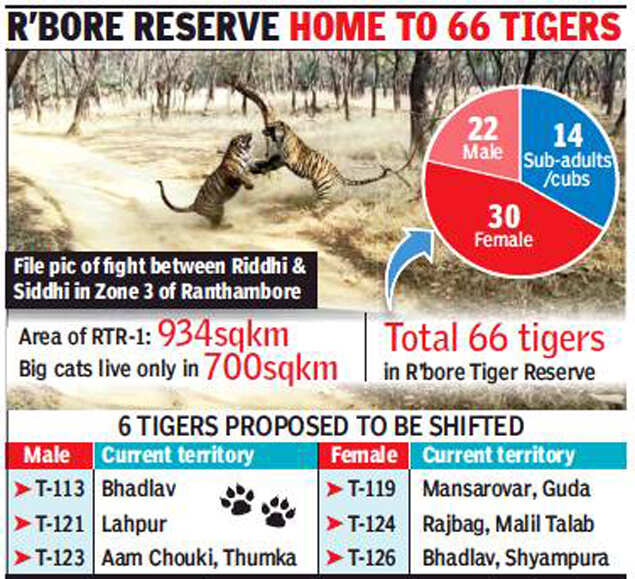Squeezed for space, 6 young RTR tigers in relocation limbo | Jaipur News


As tigers in the reserve are squeezed for territory due to high density, the chief conservator of forest (CCF) had put forward a proposal to relocate six of them. Three tigers and three tigresses, aged between 2.5 years and four years, were zeroed in for shifting and the proposal sent to the chief wildlife warden (CWLW). The list consisted of male tigers T-113, T-121 and T-123 and female tigers T-119, T-124 and T-126.
But many believe the proposal will never see the light of the day as Rajasthan does not have a safe habitat to relocate these tigers.
Speaking to TOI, chief wildlife warden Mohan Lal Meena said, “We have received the proposal to relocate tigers and it’s under consideration. However, before shifting we have to critically examine various aspects, including habitat development, prey base augmentation and village relocation, to provide safe habitat for tigers in the new reserve.”
According to a source, these young tigers are living on the periphery of the park due to severe space crunch. The problem has to be addressed urgently to prevent increasing human-tiger conflicts and deaths in territorial fights. “Last year, young tiger T-123 mauled a man to death in a village near Baler. Similarly, in Lahpur region, T-121 is facing pressure from three tigers T-96, T-120 and T-57. As they remain at risk, an action plan is the need of the hour.”
Officials say there are 52 adult big cats (30 tigresses and 22 tigers) in RTR-1, the highest in its history. As per the estimates, 7-8 adult tigers are jostling for space in less than 100sqkm area. “Out of total 934sqkm area of RTR-1, only 700sqkm is used by tigers. As per a rough estimate, a male tiger requires an area of approximately 25sqkm and a female about 15sqkm. This shows how the big cats are cramped for space,” said an official.
“In the past, the forest department failed to develop Kailadevi Wildlife Sanctuary and Ramgarh Vishdhari Wildlife Sanctuary, adjoining the forest areas of Ranthambore. This was the best possible solution. In the present scenario, these are regions where big cats can be relocated. Work should be initiated with immediate effect to develop Kailadevi till Dholpur and Ramgarh,” said a senior official.
According to an official source, the proposal to declare Ramgarh as protected area has been long pending before the state government. Moreover, the National Tiger Conservation Authority (NTCA) is at loggerheads with the state forest department to shift tigers to Mukundra Hills Tiger Reserve (MHTR). “As inbreeding is suspected in Sariska, it will not be feasible to relocate all the big cats there in the reserve.”
Dharmendra Khandal, a conservation biologist, said, “Conservation of forests is not an important priority for the state and central governments as it’s an expensive affair. The forest department is helpless in improving the habitat due to the absence of funds. Serious efforts to develop other areas for tigers should be made and funds allocated for the purpose.”




